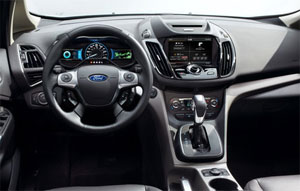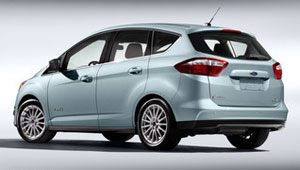2013 Ford C-Max Hybrid
The Toyota Prius is the undisputed benchmark of hybrid vehicles. But, as the Prius lineup expands with new models, so too does the opportunity for rivals to do it better. And that’s where we find the latest in Ford’s eco-friendly lineup, the C-MAX Hybrid. So is the Blue Oval really trying to topple the king of green motoring? Or has Ford just gone mad?
It’s rare when we consider Ford to be an underdog. But in the unsettled landscape of hybrid and electric vehicles, they’ve only just begun to get serious during the last few years. And so, in the spirit of this new frontier, we headed out west, to Southern California, to see if the 2013 Ford C-MAX Hybrid is a true futuristic road warrior.
While new to us as a full-hybrid, the C-MAX Hybrid actually enters the U.S. in its second generation, having been available in Europe as a non-hybrid since 2003. Important because, while styling is on the blander side, it has greatly improved. Its 5-door minivan-like shell actually includes 4 front-hinge doors…like the original Honda Odyssey minivan…with the 5th being a large liftgate. Option up, and you can get the “open sesame” foot wiggle feature first seen here on the Ford Escape.
The snub-nosed front end features an open mouth intake below a thin slit grille housing the Ford emblem. Flanked between swept head lights, they do their best to bring a little style to a segment lacking in the looks department.
But along its profile, and from behind, the C-MAX falls a little flat. Save for a few body lines, and fender wrapping tail lights, not much jumps out; a surprising approach considering the new Fusion’s dynamic redesign.
 The interior follows in conservative fashion, keeping things simple but comfortable. Dual LCD screen “SmartGauges” surround an analog speedometer, and feature vehicle information, controls, and green driving tips. SYNC with MyFord Touch returns, though we didn’t find this iteration as problematic as before. Back seats offered plenty of legroom, and total passenger volume of 99.7 cubic feet beats the rival Prius V wagon. Behind the second row 60/40 split seats is 24.5 cubic feet of luggage space. That’s nearly a third less than the V but still adequate.
The interior follows in conservative fashion, keeping things simple but comfortable. Dual LCD screen “SmartGauges” surround an analog speedometer, and feature vehicle information, controls, and green driving tips. SYNC with MyFord Touch returns, though we didn’t find this iteration as problematic as before. Back seats offered plenty of legroom, and total passenger volume of 99.7 cubic feet beats the rival Prius V wagon. Behind the second row 60/40 split seats is 24.5 cubic feet of luggage space. That’s nearly a third less than the V but still adequate.
The C-Max Hybrid’s batteries are under a raised cargo floor. But rather than the V’s familiar Nickel-Metal Hydride batteries, it’s a 1.4 kWh Lithium Ion battery pack.
Under the hood is a 2.0 liter Atkinson Cycle I-4 engine, stirring up 141 horsepower, and 129 lb-ft of torque. The electric motor next door buzzes up 118 horsepower, and 117 lb-ft of torque. Total system output is 188 horsepower. That’s 54 more than the Prius V.
And behind the wheel of the C-MAX Hybrid, that extra power was much appreciated. Driving felt completely unhindered, as the entire system works seamlessly. The electric motor supplies the majority of vehicle power up to 62 miles per hour. Full gasoline mode kicks in at higher speeds and under hard acceleration. A regenerative brake system helps on the recharge, but strong pedal resistance and grabby brakes made for some awkward stop-and-go jerks.
Things are certainly smooth with Government Fuel Economy ratings, however, at 47 mpg city, highway, and combined, through a CVT automatic. On paper, that beats the Prius V’s 42 mpg combined. Through a day of mixed California driving, however, we found a combined average in the high 30s more realistic.
Energy impact scores are great, with just 7.0 barrels of annual oil consumption, and yearly CO2 emissions at a very low 3.1 tons.
 Priced to compete, the 2013 Ford C-MAX Hybrid SE starts at $25,995, almost $1,500 below the Prius V. SEL trim rings up $28,995. And due in the spring is the C-MAX Energi, a plug in hybrid with a 21 mile electric driving range and prices starting near $34,000.
Priced to compete, the 2013 Ford C-MAX Hybrid SE starts at $25,995, almost $1,500 below the Prius V. SEL trim rings up $28,995. And due in the spring is the C-MAX Energi, a plug in hybrid with a 21 mile electric driving range and prices starting near $34,000.
It’s good to see a little diversity in the hybrid market. And while the 2013 Ford C-MAX Hybrid may not turn any heads, it’s also not an “in-your-face” electrified-“Mad Max” desperate for attention. It is a vehicle with a simple purpose; delivering outstanding fuel economy with flexible practicality. It’s a mild-mannered family hauler that could be real competition for the Prius clan, as it cruises to the top level of the hybrid car ranks.
Specifications
- Engine: 2.0 liter Atkinson Cycle I-4
- Horsepower: 141
- Torque: 129 lb-ft.
- EPA: 47 mpg city/ highway
- Energy Impact: 7.0 barrels of oil/yr
- CO2 Emissions: 3.1 tons/yr






